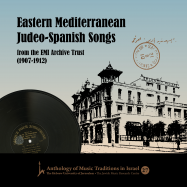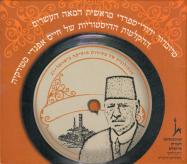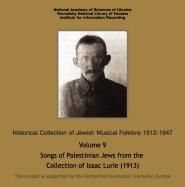(884 results found)
2. Grande displacer me haces (Jacob Algava)
… querid’ amor que me ibas a tomar. … 10 … 7 … 40789 … Eastern Mediterranean Judeo-Spanish Songs from the EMI … … Sephardic music … Salonica … Saloniki … Thessaloniki … Eastern Sephardi … 2. Grande displacer me haces (Jacob …
1. Los árboles de almendra (Jacob Algava)
… qu’ansi salió la bella que yo amo. … 10 … 7 … 40787 … Eastern Mediterranean Judeo-Spanish Songs from the EMI … … Sephardic music … Salonica … Saloniki … Thessaloniki … Eastern Sephardi … 1. Los árboles de almendra (Jacob Algava) …
Qiddush (kidousche)
… A classical Eastern Sephardi rendition of the Sabbath Eve Qiddush (the …
El lifne [sic] har Galil (shir hatunah)
… is Yigdal Elohim hai ve-yishtabah . In Sephardic and Middle Eastern traditions this anthem is sung at the end of the …
Samai and Taqsim in Maqam Farah Faza
… darbouka … Taqsim: Instrumental Improvisation in Near Eastern Traditions … Twentieth (20th) Century … Taqsim (pl. … 20th (Twentieth) Century … Arab Music … Darabukkah … Middle East … Oud … Violin … Samai and Taqsim in Maqam Farah Faza …
Taqsim in Maqam Rast Nawa
… Elias, violin … Taqsim: Instrumental Improvisation in Near Eastern Traditions … Twentieth (20th) Century … Taqsim (pl. … Taqasim) … 20th (Twentieth) Century … Arab Music … Middle East … Violin … Taqsim in Maqam Rast Nawa …
Taqsim and Qitah in Maqam Saba
… Elias, nay … Taqsim: Instrumental Improvisation in Near Eastern Traditions … Twentieth (20th) Century … Taqsim (pl. … Taqasim) … 20th (Twentieth) Century … Arab Music … Middle East … Nay … Taqsim and Qitah in Maqam Saba …
Taqsim in Maqam Farah Faza
… Salman, qanun … Taqsim: Instrumental Improvisation in Near Eastern Traditions … Twentieth (20th) Century … Taqsim (pl. … Taqasim) … 20th (Twentieth) Century … Arab Music … Middle East … Qanun … Taqsim in Maqam Farah Faza …
Taqsim in Maqam Madmi
… Elias, nay … Taqsim: Instrumental Improvisation in Near Eastern Traditions … Twentieth (20th) Century … Taqsim (pl. … Taqasim) … 20th (Twentieth) Century … Arab Music … Middle East … Nay … Taqsim in Maqam Madmi …
Taqsim in Maqam Hijaz
… Shaheen, oud … Taqsim: Instrumental Improvisation in Near Eastern Traditions … Twentieth (20th) Century … 20th (Twentieth) Century … Arab Music … Middle East … Oud … Taqsim (pl. Taqasim) … Taqsim in Maqam Hijaz …






